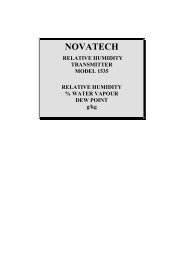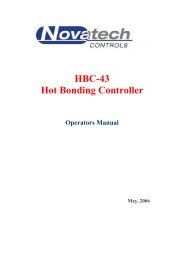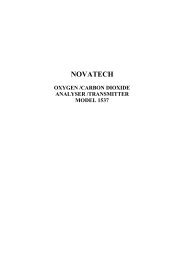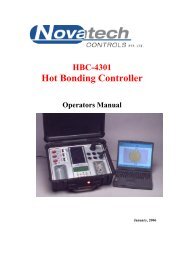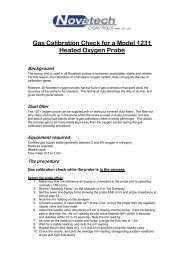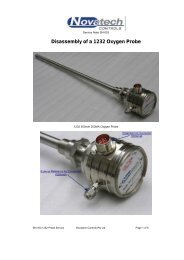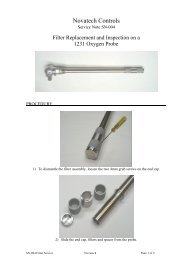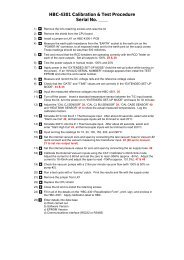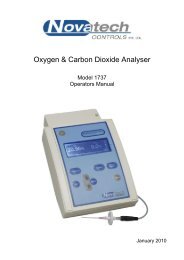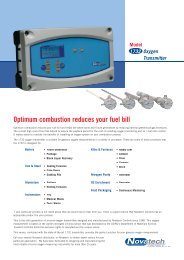ZIRCONIA OXYGEN PROBE OUTPUT (mV) - Novatech Controls
ZIRCONIA OXYGEN PROBE OUTPUT (mV) - Novatech Controls
ZIRCONIA OXYGEN PROBE OUTPUT (mV) - Novatech Controls
You also want an ePaper? Increase the reach of your titles
YUMPU automatically turns print PDFs into web optimized ePapers that Google loves.
3.26 CALIBRATION GAS SET-UP PROCEDURE<br />
If the installation has a filter purge facility, set this up first. Refer to the previous paragraph. Press the zero offset<br />
valve to obtain a reasonable flow through the calibration gas flow meter. Leave the pressure set on the air regulator<br />
for filter purge and adjust the flow on the rotameter flow regulator. The flow requirements vary depending upon<br />
the length of the probe and whether or not the probe has a filter. Required flows normally range from 5 –20 1itres<br />
per minute.<br />
Probes without filters will require a higher flow to achieve an accurate calibration gas reading and sometimes may<br />
not exactly read the calibration gas due to equilabration of the calibration gas with the process gas near the sensor.<br />
So long as the reading is reasonably close, accuracy is guaranteed, because the sensor is an absolute device. With<br />
the probe removed from service, a filter can be temporarily held over the sensing end of the probe to obtain an<br />
accurate check of oxygen readings. It is mainly for probes with no filters that acceptable accuracies can be entered<br />
in Set-up mode. Too high a flow will cause cooling of the sensor, creating errors.<br />
With heated probes that have no filter, a compromise flow rate may be required. For this reason an acceptable<br />
accuracy level can be set in the instrument to avoid nuisance ‘GAS CAL ERROR’ alarms. Once this flow has been<br />
set, the calibration gas solenoids should be manually operated from the instrument keyboard by pressing the ‘CAL<br />
1’ or ‘CAL 2’ button whilst in ‘RUN’ mode. The calibration gas cylinder pressure should be gradually increased to<br />
achieve exactly the same flow reading on the flow metre as the zero offset flow, without adjusting the rotameter<br />
flow regulator. Calibration gas flow(s) and the zero offset flow should be identical. Some adjustments may be<br />
required to obtain satisfactory results with calibration gas flows.<br />
The maximum pressure on the calibration gas cylinders is 100 kPa (15 psi). 30 kPa (5 psi) is sufficient, particularly<br />
when no purge option is installed. Use a calibration gas close to the normal operating oxygen level to avoid a long<br />
recovery time.<br />
3.27 DUST IN THE FLUE GAS<br />
For unheated probes with no filter, entrained solids or dust in the flue gas does not present a problem unless the<br />
dust, when settled, is not porous. Allow the dust in the process to build up on the probe. It will form a porous layer<br />
slowing the response time. To avoid mechanical abrasion of the electrode material pack ‘SAFFIL’ or equivalent<br />
alumina based ceramic fibre in the sensing holes to protect the electrode. Do not use silica based ceramic fibres<br />
such as ‘KAOWOOL’, which can attack the electrode at high temperatures. Once the dust has built up the<br />
response time of the probe will be slower.<br />
For heated probes the preferred method of mounting for dust laden applications is facing vertically downwards<br />
with the filter removed. With no filter, some errors in gas calibration can occur when the gas sample has an<br />
oxygen content significantly different from that of the flue gas. Allow for this when setting auto-calibration<br />
tolerances in the Set-up mode.<br />
Probes can also be mounted horizontally with no filter with some dusts. An occasional automatic back purge is<br />
helpful in this case.<br />
Normally heated probes are supplied with filters for dusty applications or with flow guide tubes with filters. The<br />
probe response line should be tested when the probe is first installed, and then regularly until it remains constant<br />
for a significant period. Filter purging should be set up on the time periods determined by these tests. To test the<br />
probe response time, use a stop watch to obtain the time for a probe to achieve a 63 % change from one reading to<br />
another.<br />
If a probe filter blocks completely in a short period of time, then there is no option but to use the probe without the<br />
filter. A trial probe with filter is available to test whether filter blockage is likely to occur.<br />
3.28 STRATIFICATION<br />
If the analyser and probe have been fully tested and the oxygen readings in the flue gas are incorrect, gas<br />
stratification may be occurring. The phenomena cannot be anticipated for any particular installation. Generally,<br />
large flues have oxygen differences of approximately one percent across the flue. Occasionally an oxygen error of<br />
several percent may occur in a flue of any size. This problem is normally solved by moving the probe to a new<br />
location.<br />
3.14 NOVATECH <strong>OXYGEN</strong> ANALYSER



